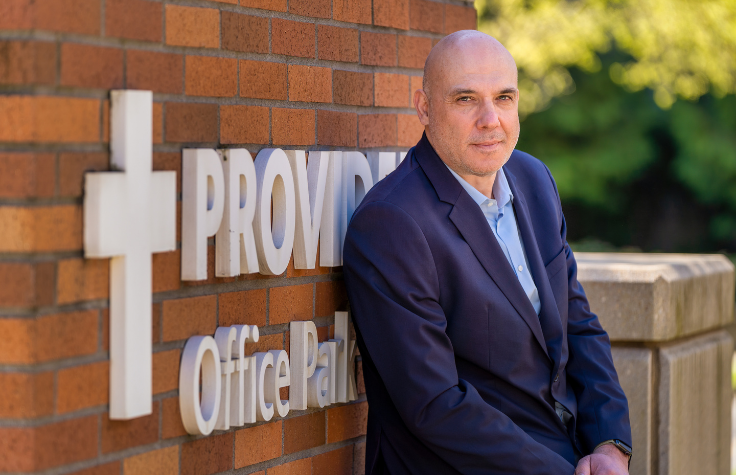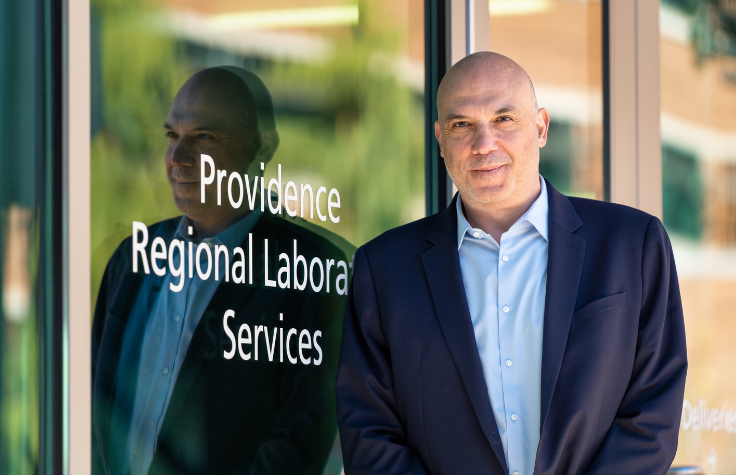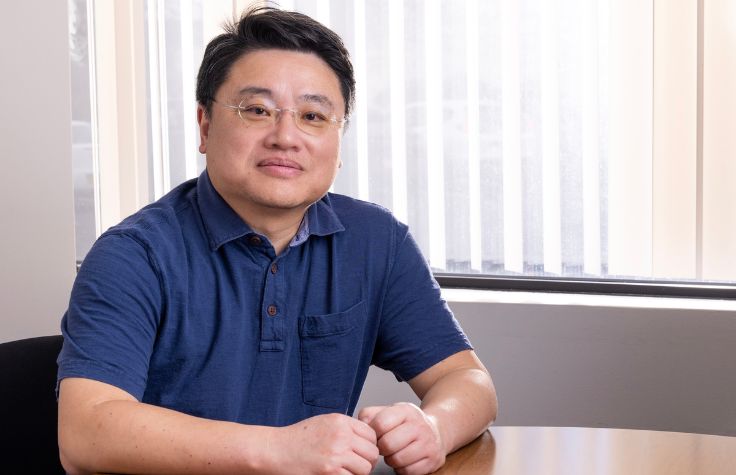
August 9, 2021
In the future, what if you could sequence your cancer patients by the thousands, provide answers quicker, and deliver more effective treatment and better care—on a routine basis? For , the nation’s third largest not-for-profit health system, that future is the present.
At Providence Molecular Genomics Laboratory, which serves the entire Providence health system, Carlo Bifulco is the medical director who also oversees . He joined the Portland-based team in 2008 by way of Milan, Yale, and Memorial Sloan-Kettering, drawn by the fact that Providence was at the forefront of immuno-oncology (IO), a field of medicine that uses the body’s immune system to fight cancer. Now with a rapidly growing team of pathologists and bioinformaticians on staff, the lab is emerging as one of America’s largest clinical genomics operations. Founded in 1859, Providence comprises 51 hospitals and 1,085 clinics in seven western states from Alaska to Texas.
The Providence Molecular Genomics Lab offers genomics to all of them. They run two VR���˲�Ʊ NovaSeq™ 6000 instruments “continuously.” They perform Comprehensive Genomic Profiling (CGP), which uses next-generation sequencing to assess hundreds of cancer biomarkers from numerous tumor types in a single test. Providence’s CGP service, called the , can point patients toward targeted or immunotherapies that might not have been identified through single gene tests or panels.
In order to enable GenOmic CGP testing, Providence implemented VR���˲�Ʊ’s TruSight™ Oncology 500 (TSO 500) assay in-house two years ago. TSO 500 is a Research Use Only comprehensive pan-cancer assay designed to analyze 523 genes and genomic signatures, covering tumor biomarkers linked to guidelines and clinical trials. TSO 500 evaluates both DNA and RNA from tumor samples to identify key somatic variants—or changes in the genetic code—critical for cancer development and progression, such as small DNA variants, fusions, and splice variants.
Despite the advent of such technology, we’re still living in a time when most tumors are not sequenced. Fortunately, Bifulco had no trouble selling the cancer profiling program to Providence’s powers-that-be. “It is really driven by clinical need,” says Bifulco. “If you think of what CGP is competing with, either very small panels of genes or a sequential kind of testing where you do one gene test at a time, both of those options are obsolete, quite frankly when you can test against hundreds of genes and biomarkers at once. They’re not really what the oncologist wants to see for patient care.”
Validating the test in-house—in other words, proving its accuracy and reproducibility in delivering results—was not difficult, either, as they already had whole exome and small panel data sets to enable the validation. “It was a relatively easy process because of what we had available as a backbone,” says Bifulco. “So it was a little bit of an unusual pathway.”
The challenge—and he believes it is their greatest—has been keeping up with increasing volumes and all the informatics and data that come with it.
“We make a difference every day and we see it at every level.”
Saving time and tissue
Where they are gaining ground is in turnaround time, or TAT. To minimize costs with molecular testing, labs will often perform one single-gene or small panel test at a time, wait for the first negative result, then go for a second round, and if that is negative, go for a third round. Sometimes the pathologist must go back to a slide, or back to the tissue (which by then may be damaged or used up), or back to the patient to take more samples. This piecemeal approach is time-consuming and takes a minimum of three weeks. Using the comprehensive approach, Providence aims for a 10-working day TAT, shaving off at least a week if not a lot more—which can be critical when the cancer is advanced at presentation.
In addition to consuming time, the conventional methods consume tissue—and Bifulco has seen a big improvement in this area. CGP is especially helpful when the biopsy sample is very small or the tumor is in an inaccessible location. “If you order sequential tests, you may end up never getting to the test you want because the tissue has been completely depleted in multiple attempts of making single gene tests one at a time. The end result is that even getting a result is impossible. And it’s rather common for very small samples to have a situation where there is no tissue leftover for the test which is needed. CGP prevents that kind of scenario completely.”

Throwing criteria out the window
At first, Bifulco’s lab prioritized anyone whose cancer was advanced or who had the kind of tumor that is intrinsically going to behave very aggressively. Then everyone with metastatic disease received the test. And then patients with tumor types like brain or pancreatic—where treatment options are minimal—received CGP, independent of stage. “And then we gave the option to clinicians to make it applicable to any tumor independent of any kind of criteria. We found some clinicians were already receptive to running it all the time.”
Not only is Providence offering GenOmic CGP testing to anyone and everyone who orders it—they’re changing how and when they deliver it. “These tests are traditionally ordered by the oncologist at a time when conventional therapies are not applicable anymore,” Bifulco explains. “They’re usually being done when people are metastatic or have advanced disease and chemo is basically no longer an option. At that stage, folks really seek out targeted therapies and personalized medicine approaches. Our intent is to offer CGP at the first sign of a tumor, as soon as it is acknowledged by the pathologist. I think this approach will be a gamechanger for patient care.” Bifulco’s ideal scenario is to deliver GenOmic CGP testing to everybody, with any kind of cancer, independent of stage, as early as possible. Interim results from an ongoing study showed that GenOmic CGP testing provided actionable results in more than half of the tested patients.
Providence has now run GenOmic CGP testing for around 10,000 patients. “One of the biggest values of CGP compared to single gene or small panel tests has to do with a biomarker called TMB, tumor mutational burden,” says Bifulco. TMB is defined as the number of non-inherited genetic mutations per million bases of investigated genomic sequence and is a marker of cancer that has been enabled by next-generation sequencing. “Getting TMB from a small panel is impossible by definition because you need to sequence enough of the tumor genome to accurately calculate TMB. Patients with high TMB have been shown to benefit from certain types of IO therapy, so assessing TMB makes immuno-therapies a viable option for way larger numbers.”
Previously, melanoma and lung cancer were the two main tumor types that could qualify a patient for IO. But now evidence is showing that patients with many tumor types might benefit from IO therapy if they have high TMB. “We can see a high TMB across multiple tumor types,” he says, citing bladder and neuroendocrine tumors as examples.
The impact of diagnostics
“We make a difference every day and we see it at every level—at the level of therapy, of people being eligible for therapies that would have never been given to the patient. We also see an impact on the diagnostic process,” he explains, referencing scenarios where genomic findings corrected a prior diagnosis and completely altered the case. Finally, they see an impact on tumor staging. When a patient has multiple tumors, it’s not always easy to see their relationship. Is it many independent tumors at an early stage, or the same tumor type that has metastasized, which would classify as a later stage of cancer? “CGP delivers more accurate information and becomes a really crucial piece of the pathological workflow.” He recalls several oncologists showing surprise and relief when this type of comprehensive testing reversed a bleak picture but says we still need to expand recognition of the utility of testing.
“I think it’s a pity. I often feel testing is like a second-class citizen. People focus on the therapy link and we spend millions of dollars on therapies, but we are very cheap on the testing side and I think we are putting the cart before the horse. Testing is really the driver.”
"I see us standing at the precipice of a new era that we could hardly imagine 10 or 20 years ago. We’re looking forward to very exciting times ahead.”
Building an ecosystem
“We’ve taken the first good steps in the right direction, but you also need to build an ecosystem which empowers CGP testing,” says Bifulco. That means building awareness, educating physicians, matching patients to trials, and changing reimbursement models.
Once that happens, it will be easier to provide even better testing and care beyond CGP testing. “Things are very isolated right now—patients are in the hands of one oncologist at a time, and there’s no good way to aggregate all these big data sets in a dynamic kind of fashion.” A lung cancer patient with an EGFR mutation might respond to an EGFR inhibitor for a few years. But if there is a recurrence, or resistance, there might be a stage where the person would benefit from a clinical trial. The idea, he says, is to use machine learning to recognize an event of progression automatically and in real time on the electronic medical record (EMR) system. This would happen across very large cohorts of all their patients and then the system would dynamically match them with Providence’s GenOmic data sets. Every time a patient's disease progresses, they would know potentially what trials could be applicable to the patient.
Looking ahead, Bifulco wants to move beyond the current tumor-only approach, adding what he calls “layers on top of CGP.” They want to improve in their assessment of the tumor microenvironment which requires work on image analysis and data integration. They’ll look at the RNA layer, the methylation layer, and do whole-genome sequencing of all these things all the time. “Inevitably we’ll have a much deeper, more systematic integration of genomics into our workup of the patients, routinely applied all the time. Then as they go through therapies, we’ll do routine comprehensive monitoring of the patients through genomic tools such as liquid biopsies, and do a proper analysis of the interactions. You will see this done at scale and routinely. I think it would be cost-effective and could significantly impact outcomes. It’s only a matter of when.”
“With genomics we really have an opportunity to shift the scales in oncology and how we approach proactive, personalized patient care overall. I see us standing at the precipice of a new era that we could hardly imagine 10 or 20 years ago. We’re looking forward to very exciting times ahead.”


